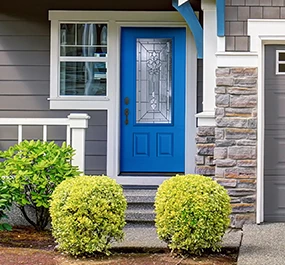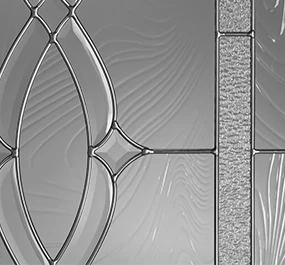Can you paint a fiberglass door? It’s a question many homeowners have asked themselves or sleuthed for on the web.
Fiberglass doors are held in high regard for their functionality and aesthetic beauty, yet most homeowners eventually have the urge to add a fresh new look. Painting your fiberglass door is one way to ramp up curb appeal and refresh your home’s exterior for your benefit. You can paint your door or rely on a professional.
Understanding Fiberglass and Paint Compatibility
While it might seem like a simple process on the surface, painting your fiberglass door involves several preparatory steps, starting with choosing the correct type of paint. Fiberglass interacts differently with each unique type of paint. Select the right paint for your door, prep the surface, and consider relying on a professional for assistance.
Ideally, your door will be a Plastpro fiberglass door made with paintability in mind. Our doors are compatible with different types of paint, ensuring your selected aesthetic comes to life while maintaining performance and durability.
Advantages of Repainting Fiberglass Doors
Plastpro fiberglass doors can be repainted with surprising ease. Choose a fiberglass door designed for the addition of your choice of paint and the fresh coat will revitalize this entrance to your home.
The new aesthetic will lift your spirit along with your property’s curb appeal. Repainting a fiberglass door also protects against harsh weather. Plastpro fiberglass doors feature a flexible design that allows homeowners to alter styles exactly as desired in the years that follow.
Steps to Painting a Fiberglass Door
You can paint your fiberglass door on your own or hire a professional. Regardless of whether you elect to embrace the DIY (do it yourself) approach or lean on a pro for the project, it is up to you to select the perfect new color for your fiberglass door. Be aware of the type of paint compatible with your door.
Preparing the Surface
Once you’ve selected the new paint for your fiberglass door, shift your attention to the door itself. The surface of the door must be prepped, beginning with a thorough cleaning. The next step is to prime the door, ensuring the surface is smooth and ready for the addition of a new coat of paint. However, each step in prepping the door surface requires extensive attention to detail as highlighted below.
Cleaning the door helps ensure the new coat of paint will adhere. Some painters recommend using soap for a more thorough cleaning. Be sure to rinse the door after applying a cleaning substance such as soap. If the door has residue after a wash and wipe down, rinse it with water. Professionals go to the extent of cleaning the door with a rag or small towel dunked in a cleaning solution such as acetone or mineral spirits.
If there are any visible nail holes, address them before beginning the painting process. In particular, transitioning to a lighter hue will make nail holes that much easier to see, meaning now is the best time to fill them. Wood filler will suffice for nail holes as it dries quickly, allowing you to perform a quick light sanding for a smooth surface suitable for a fresh new coat of paint.
After cleaning the door and giving it at least an hour to dry, shift your focus to sanding. In addition to sandpaper, the project will also require additional tools such as paintbrushes, paint, protective gear, drop cloths, and primer.
Sanding is necessary for a smooth door surface, setting the stage for primer and paint application. The best sandpaper variety for front doors is that of the 120-grit variety. This sandpaper provides adequate texture without compromising the fiberglass itself.
A word to the wise: don protective gloves when sanding the door. There is even the chance of tiny particles from the door surface bouncing toward your eyes so be sure to wear safety glasses.
Now that the door is ready, add thin layers with two coats of thickness. However, the second application should not occur until the first fully dries. We would be remiss not to mention that primer must be compatible with the fiberglass and selected color as detailed below.
Choosing the Right Paint
Take a look at the paint varieties on the market and you’ll find an abundance of options. However, only certain types of paint are compatible with fiberglass doors. When in doubt, lean toward replacing your current door with a Plastpro fiberglass door that accommodates new coats of different types of paint better than the rest.
Drive or stroll around local neighborhoods to check out examples of freshly painted fiberglass doors, getting a sense of the different paint hues and finishes, be it semi-gloss, matte, etc. Use your mind’s eye to envision those doors at your property.
When whittling down the field of paint types, opt for paint with specific characteristics and merits. As an example, some of the top factors to consider when choosing a type of paint for fiberglass include the resistance to the sun’s ultraviolet (UV) rays, finish, and level of weatherproofing.
Choose a paint designed for application on metal and/or plastic doors. When in doubt, opt for acrylic latex paint as it stands the test of time without fading or otherwise faltering. Oil-based paints are also an option though they aren’t preferable, especially when other options are available.
If you are on the fence between two types of paint, opt for the one with the best reputation for durability. Keep in mind that your home’s front door will be exposed to the elements, meaning its sturdiness and durability are of the utmost importance. However, what matters most is that the paint you select is rated for application on fiberglass doors.
If your fiberglass door is epoxy resin, choose a paint that is also epoxy-based. If your home’s front door is made of polyester-resin fiberglass, choose a paint that is polyester-based. In general, lacquer paint is not used to paint fiberglass doors though oil-based paints are a last resort option.
Applying the Paint
Painting a fiberglass door requires patience and attention to detail. If you are short on time or dread the prospect of painting your home’s front door, hire a professional to do the job.
Before applying the paint, slowly stir it within the can. The purpose of slowly stirring the freshly opened paint can is that the swirling motion creates more of an even mixture. Beware of stirring too quickly as a rapid motion will result in the formation of bubbles.
If you paint your fiberglass door yourself, paint from the top down, focusing on balancing paint application across the entirety of the door for an even coat. Use even and flowing strokes for a smooth application that prevents dripping.
The best-looking doors are the result of two coats of fresh paint. Allow the initial coat to dry then apply a second layer for a professional-looking door that you are proud to present to the neighborhood.
Considerations When Painting Fiberglass Doors
If you are a bit nervous when entertaining the idea of painting your home’s fiberglass door, rest assured that the hesitance is completely normal. Attention to detail, precision, and focus are critically important to painting your home’s entrance the right way on the first attempt.
Place painting tape around the edges of the surrounding doorway and glass to prevent stray paint from moving beyond the door.
If your fiberglass door has a warranty, read through it before painting. There is a chance that painting your fiberglass door will void or otherwise affect an active warranty. Staining the door is also worth considering.
Transforming Your Plastpro Door: Resources and Support
Plastpro helps homeowners like you bring out the best in the home in functionality and form. We invite you to check out our supplemental content including helpful How-To Guides and Tutorials from the Plastpro team.
Make your way over to our Blog to tap into an invaluable resource for improving home aesthetics and functionality.
Transform Your Entryway with Plastpro
It is time to elevate your home’s curb appeal to the next level. Paint your fiberglass door and your home really will have a new look and feel. A double coat of fresh new paint is the perfect welcome for family, friends, and other visitors.
Plastpro’s fiberglass doors are compatible with homeowners’ unique aesthetic preferences. Think of your Plastpro fiberglass door as a canvas that lets you put your unique creativity on display. We also make door hinges, sidelights, speakeasies, and more.
You can take a look at Plastpro’s selections from local distributors using our Where to Buy Page.



